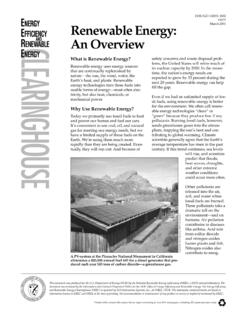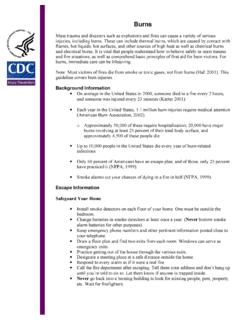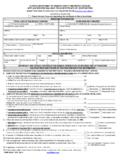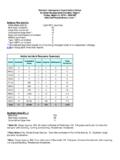Transcription of Electrolytic Copper Plating Additives and Contaminants
1 Electrolytic Copper Plating Additives and Contaminants Wayne Jones Electrolytic Copper Plating Chemistry Typical DC Acid Copper Electroplating Solution contains: > Inorganic Sulfuric Acid (180 - 250 g/l). Copper Sulfate (40 - 100 g/l). Hydrochloric Acid (25 - 100 mg/l). > Organic Brightener (2 - 10 mls/l). Leveler (5 - 15 mls/l). Carrier (25 - 100 mls/l). > Water (Balance). 2. Electrolyte Control Sulfuric Acid Virtually unconsumed Dragout Titration or Specific Gravity Copper Sulfate Maintained by Anode Erosion Titration, UV/Vis Chloride Maintained by chemical analysis Titration, Ion Specific Electrode, UV/Vis 3. Additives Mostly Proprietary Brighteners are Plating accelerators, which act as a micro-leveler and impact grain refinement. They tend to be attracted to cathode induction zone points of higher electro- potential, temporarily packing the area and forcing Copper to deposit elsewhere.
2 As the Copper deposit levels, the local point of high potential disappears and the brightener drifts away, as well as depleting (hydrolysis) to a higher level of activity. Chemical Family - Organic Sulfides, Disulfides, Thioethers, Thiocarbamates. Levelers are strong secondary Plating inhibitors, which typically co-function with Brighteners to reduce Copper growth at protrusions and edges. They improve mass transfer to localized sites of lesser electro-potential or feature height. Chemical Family Quaternary Nitrogen Cmpd. Carriers are Plating inhibitors or suppressors, they create and maintain a defined diffusion layer at the Anode (which regulate the flow of Cu+2 ions into the electrolyte and ultimately to the cathode (board surface). Carrier depletion occurs as the PEG cleaves. Chemical Family Polyethylene Glycol (PEG), Polyalkylene Glycol (PAG). Chlorides mild Plating inhibitors, which stabilizes the Cu+1 ion that serves as an intermediate in the electro-deposition process during reduction to Cu +2.)
3 Additionally they modify adsorption properties of carrier to influence thickness distribution. Chemical Family Hydrochloric Acid 4. Hull Cell Additive Control ASF 75, Needs Brightener Carbon Treated Copper Bath ASF 90, Proper Operating Range 5. CVS/CPVS Cyclic (Pulse) Voltammetery Stripping CVS/CPVS is an indirect bath measurement which measures the combined effect of the Additives and by-products on the Plating quality 6. CVS and CPVS Instrumentation 7. Copper Anodes Phosphorized: 150 650 ppm P. Oxygen Free Casting Typical Chemical Analysis Grain structure grows from surface Contam inant Concentration, Wt %. to the center, resulting in uniform Lead corrosion of the anode. Zinc Nickel Iron Anodes are conditioned when new Sulfur < by developing a necessary black Antimony CuO film Dummying. Arsenic Silver < Tin Balls, Nuggets, Bars. Anode surface area and continuous bath agitation is critical.
4 8. Pattern Plating 1) Full panel Electroless Copper deposition. 2) Photoresist apply, expose with positive image artwork - majority of Copper surface shielded, develop. a) Reduced electroplated surface. b) Lower current capacity required. c) Less Copper anode bank consumption. d) Less Copper in etchant. 3) Plate Copper , Plate Tin (Etch Resist). a) Adds several additional wet process baths. 4) Strip Photoresist Potassium Carbonate 5) Etch Copper Ammoniacal 6) Strip Tin Resist Nitric Acid 7) Antioxidant - BTA. 9. Panel Plating 1) Full panel Electroless Copper deposition. 2) Full panel Electrolytic Copper plated. a) Higher current capacity required. b) Significant Copper anode bank erosion. c) Smooth, even, bright finish on panel and hole walls. d) Easily cleaned/prep'd for downstream processing. 3) Photoresist apply Negative Image 4) Develop - Carbonate 5) Etch Ammoniacal or Cupric Chloride a) Significant Copper buildup in etch, more maintenance.
5 6) Strip Potassium Hydroxide 7) Antioxidant - BTA. 10. Contaminants Drag in / Leach Out Inorganics ICP / GFAA analysis Trace Metals Iron (Fe). Calcium (Ca). Tin (Sn). Lead (Pb). Nickel (Ni). Antimony (Sb). Organics Hull Cell / CVS / TOC. Cleaner/Predip surfactants (inactive). Resist Photo-initiators (inactive). Anode Bag Sizing (inactive). Additive breakdown products / fragmentation (active). 11. Chemistry Impact / FMEA. Inorganic Organic Defect / Failure Mode CuS04 H2SO4 Cl- Brightener Leveler Carrier Burned Copper Deposit Low Low / High Low Low Poor Throwing Power High Low Poor Leveling Low Low / High Roughness Low Pitting Streaking High Poor response to Additives High High Step Plating Low Grain Structure Poor High Low Low Low Anode Color Green High Anode Color Dark Low Anode Color Bright High Soft Copper Deposit Low Brittle Copper Deposit High Low Tensile Strength Dull/Matte finish Copper Nodules High Spiked Copper Deposit Low / High 12.
6 Contaminant & Process Impact / FMEA. Contaminant / Impurities Mechanical / Electrical Defect / Failure Mode TOC Particulates Trace ASF Anodes Circulation Agitation Temp Burned Copper Deposit High High High Low Low Poor Throwing Power High High Poor Leveling High Low Roughness High High High / Low Filtration Pitting High High Low Streaking High High Poor response to Additives High High High / Low High Step Plating Grain Structure Poor Anode Color Green Anode Color Dark Anode Color Bright Soft Copper Deposit High Brittle Copper Deposit High High Low Tensile Strength High High Dull/Matte finish Copper Nodules High Low / High Spiked Copper Deposit Low / High 13. Burnt Plating Unbalanced CD / ASF. 14. Even After Microetch 15. Plating Characteristics Impact Etch Differential 16. Topography Differential SEM/BSE. 17. Copper Topography Variations (80x). Burnt Copper Plating Transitional Detectable Bright / Leveled 18.
7 Spiked Copper Surface / Knee Courtesy Sanmina-SCI, Owego 19. Spiked Copper Hole Wall Courtesy Sanmina-SCI, Owego 20. Grain Structure Failure Blind Via Courtesy Sanmina-SCI, Owego 21. Copper Chicklets Grain Structure Courtesy Sanmina-SCI, Owego 22. Cobblestones Hole Wall Courtesy Sanmina-SCI, Owego 23. Cobblestones Hole Wall Courtesy Sanmina-SCI, Owego 24. Surface Nodule Process Debris Courtesy Sanmina-SCI, Owego 25. Surface Nodule - Debris Courtesy Sanmina-SCI, Owego 26. Barrel Crack / Lam Voids 6x TS. Courtesy Sanmina-SCI, Owego 27. Summary: Surface Contaminant Evaluation Macro Level: PCB fabricator - SPC, IPC TM's and spec's, customer requirements, cleanliness, water quality, post process residues, solderability, visual inspection. Micro Level: Post fab evaluations employing FTIR, Raman Spectroscopy, HPLC, SEM - EDS/Auger, IC, ICP/GFAA. What to look for: Process residues (MOP, Resist Remnants, HW Salts, OSP)?
8 Co-plated Contaminants (inorganic / organic)? Hydrides, Oxides, Sulfides, Carbides, Halides? Gas entrapment? What's changed the most: Etch Resists (Sn vs Sn/Pb) and strip chemistry? High Temp OSP's? DC or Pulse (Reverse and Duplex) Plating and chemistry High aspect ratio? 28.




